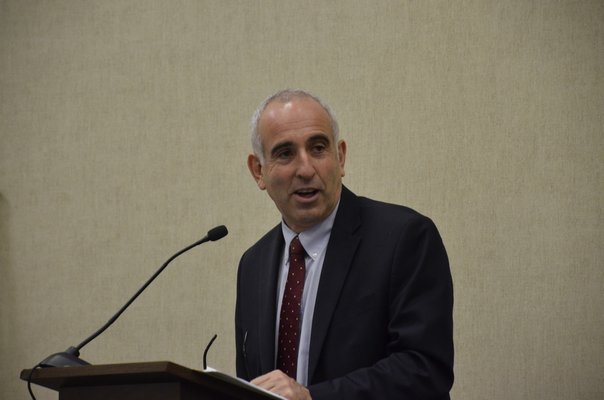
In an effort to bring more affordable housing opportunities to the Town of Southampton—primarily east of the Shinnecock Canal—Town Supervisor Jay Schneiderman is looking to loosen the restrictions on accessory apartments.
But there’s one catch: Homeowners will be limited on how much rent they can charge.
At a Town Board work session on Thursday, October 18, Mr. Schneiderman, along with Assistant Town Attorney Kara Bak, and Diana Weir, the town’s director of housing and community development, presented a plan that would allow homeowners to rent a one-bedroom accessory apartment, but they could charge no more than $1,518 per month in rent. It’s hoped that the offering would open up affordable housing opportunities to those who work in the community.
“The concept we are working on is basically to expand the inventory of affordably priced rental units in the town to give young people—not just young people—an opportunity to stay in our community to work and be able to save some money, or be able to have a decent life, because the rent isn’t gobbling up their life,” Mr. Schneiderman said.
On Tuesday, Mr. Schneiderman said giving homeowners the opportunity to rent out an accessory apartment is a privilege, because towns do not have to allow accessory apartments in the first place. So as a trade-off, he said, the town is limiting the amount that can be charged to rent an apartment.
There are a few stipulations, though.
For example, the rental must be for the entire year, and the home, or primary residence, must be occupied by the homeowner. This helps eliminate summer rentals and ensures that the renters don’t get out of hand, according to Ms. Weir.
Mr. Schneiderman also said eligible lots must be one-half acre or larger, as opposed to the current regulation of three-quarters of an acre or larger.
When the legislation was discussed during the work session, there was concern that opening accessory apartments up to homes with smaller lots would only increase the density in areas like Hampton Bays and Riverside, where the number of people per square mile exceeds 1,000.
After working with the legislation, Mr. Schneiderman said on Tuesday that he wanted to set criteria that any area with over 500 people per square mile according to the latest census would be ineligible to have an accessory apartment.
He said homeowners in Hampton Bays, East Quogue, Speonk, Quiogue, Riverside and Shinnecock Hills would be “knocked out” from being able to get an accessory apartment permit—but Bridgehampton, Eastport, Flanders, North Sea, Noyac, Water Mill and Tuckahoe would be eligible.
Mr. Schneiderman said out of the 12,000 lots in the town currently eligible to qualify for an accessory apartment permit, only 400 have permits. But increasing the pool and restricting the pricing to be more affordable does not necessarily mean more people will take advantage of the new program either, according to Mr. Schneiderman.
Optimistically, he said if 20 property owners sign up per year over the next 10 years, that’s an additional 200 affordable units in the town.
“It’s still a drop in the bucket to what’s needed, but it would better than what’s happening now,” Mr. Schneiderman said. “This is a real crisis, and the lack of affordability is impacting the community.”
He added that when there is a lack of affordable homes, traffic increases from a workforce that commutes from outside of the town, there is a lack of a sense of community, year-round populations east of the canal drop and it gets harder to find volunteers for the fire and ambulance companies.
“I’m trying to do something that makes it a little better,” Mr. Schneiderman said. “There’s no perfect solution. Doing nothing is unacceptable.”
Mr. Schneiderman said he plans to present his changes to the other board members at Thursday’s work session at 10 a.m. Once legislation is agreed upon by the board, it will be presented for a public hearing.